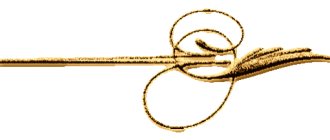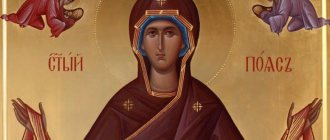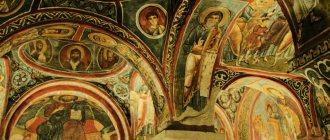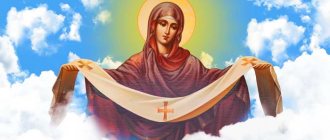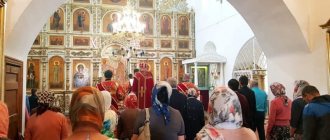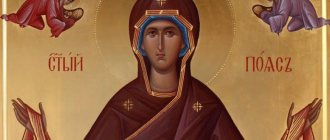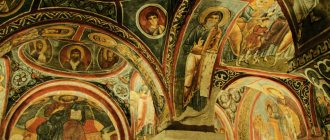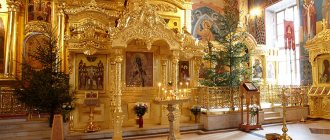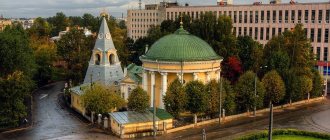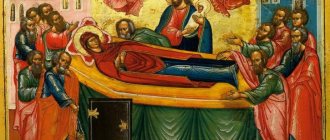The ancient holiday dedicated to the appearance of the Blessed Virgin Mary has been known since the first century, although it was described much later. According to historians, an unforgettable event took place in 910, in the city of Blachernae (a suburb of Constantinople). Now, every autumn, Orthodox Christians celebrate the Intercession of the Most Holy Theotokos; the icon of the holiday is placed in the middle of the church on this day.
About the author About the book
Among the people, the Intercession is associated with the beginning of marriages. Many temples and settlements are named in honor of the memorable date. It is not the twelfth (one of the 12 main) holidays, but one of the Great ones.
What is celebrated
The familiar name hides a deep meaning behind it. To understand it, you need to know about the events that took place in the Blachernae temple. Residents of the Byzantine state gathered that evening for joint prayer - they asked to avert the threat posed by the numerous barbarians surrounding Constantinople. Among the others was the holy fool Andrei, who saw the Mother of God in the rays of light.
Work as a courier at Yandex.Eda (up to 3,400 rubles per shift) leave a request →
Surrounded by saints and angels, she prayed tearfully. Then she took off the omophorion (that’s what part of the liturgical vestment is called) from her head and spread it over the people. It is this event that is depicted on the icon “Protection of the Most Holy Theotokos”; it means the protection and patronage of the Mother of God over Christians. The besiegers soon left, in memory of which a holiday was established.
The events of that day are described in various chronicles, for example, Patriarch Photius talks about it in detail. But why does the Intercession of the Most Holy Theotokos have such significance specifically for the residents of Russia? Icons, temples, cities and villages - the autumn holiday is deeply embedded in the people's soul. According to some historians, then the Russian princes Dir and Askold decided to attack Constantinople. The ruthless invaders were so impressed by the miracle that happened through the prayers of Christians that they decided to accept this faith.
Officially, Russia adopted the new religion a little later, but since then, from the very first century of Christianity, a special connection has been established between the Russian people and the Mother of God. After all, oddly enough, Intercession Day is celebrated only in Russia, which is surprising, given its origin. It is impossible to force people to love someone, but Russians love the Mother of God as deeply as they love their own mother and their Fatherland.
Vision of Blessed Andrew
In the depths of centuries it is difficult to discern the exact time of the appearance of this image. According to the description in the life of Andrei the Fool, the vision was a vast scene that filled the entire temple.
During the all-night vigil, which took place on the occasion of the encirclement of Constantinople by enemies, the vaults of the church seemed to dissolve. The Mother of God descended from heaven to the worshipers, accompanied by the Apostle John the Theologian and John the Baptist. Having prayed to the Lord with tears, She took the veil from her head and spread it over the people.
Not trusting his impressions, Andrei asked Epiphanius, standing nearby, if he saw the Lady praying for peace? “I see and am horrified,” whispered the saint’s faithful friend and disciple.
Andrey Yurodivy
It was no coincidence that the vision took place in the Blachernae temple. Historical sources of the 11th century. testify to a miracle occurring weekly. Over the unknown icon of the Mother of God, located in the temple, every Friday during a prayer service, the cloth covering it was raised by an invisible force.
The next morning the enemy attack was successfully repulsed. Some historians believe that the Slavs stood under the city walls that night. In this case, the intercession of the Mother of God for the Greeks was providential: after some time, Rus' accepted Baptism, making its lands the inheritance of the Blessed Virgin.
The Blachernae Church still exists today. This is practically a new building on the site of an old one, located on the outskirts of Istanbul. The walls are decorated with scenes from Andrew's vision. However, the holiday of the Intercession is not celebrated here as magnificently as in Russia.
About other Mother of God holidays:
- Annunciation of the Blessed Virgin Mary
- Introduction to the Temple of the Blessed Virgin Mary
- Dormition of the Blessed Virgin Mary
Today is the Feast of the Intercession of the Blessed Virgin Mary - one of the most revered and beloved among Orthodox Christians. It is celebrated annually on October 14 in all temples and churches.
Traditions of the Intercession in icon painting
In Rus', Pokrov has been remembered and loved for centuries - this is the day of the first baptism of Russians. Temples in memory of this holiday have been built in our country for 900 years; the iconography developed a couple of centuries later. 14th century paintings discovered in the monastery of Pskov, also in the Suzdal cathedral.
The Icon of the Intercession of the Blessed Virgin Mary has two main types of engraving (images):
- Novgorod - here the omophorion is held by angels, the Mother of God stands with her hands raised in prayer. It is located above the Royal Doors, which are closed. The Novgorod museum houses one of these icons, painted at the very end of the 14th century. Here, behind the figures, you can see a church with five domes.
- Suzdal - The Queen of Heaven stands in front of the temple, she holds her head veil over the praying people. Below her on the pulpit stands Saint Romanus with a scroll. The temple icon, which was discovered in the Suzdal monastery, is now in the Tretyakov Museum. In the background you can see basilicas and round domes of churches - a landscape typical of Byzantium.
Over time, these two options could be combined. Among the people praying in the church, you can see other saints - Leo the Wise, Patriarch Tarasius. The omophorion itself is usually painted red, although on some icons of the 16th century. it is white.
In the modern version, the Mother of God can be depicted alone in full height, an omophorion hovers above her, while she herself stands with her hands raised in prayer. Or Saint Mary herself holds the veil with both hands, turning her gaze to the person praying.
Pokrov in Rus'
In the Russian Orthodox Church, the Feast of the Intercession of the Blessed Virgin Mary is celebrated on October 14 according to the new style. The veneration of this holiday in Rus' began under the holy prince Andrei Bogolyubsky (1111-1174). Initially, this day began to be celebrated in the Vladimir-Suzdal lands. The prince built the Church of the Intercession on the Nerl (Bogolyubovo, Vladimir region). Over time, the Intercession of the Mother of God became one of the most beloved holidays of the Russian people. Moreover, for Orthodox Christians the main thing was no longer the motive of delivering the Byzantine Empire from enemy attack. The believing soul responded to the example of the intercession of the Mother of God of the Orthodox, the invisible grace-filled prayer protection.
“We believe in our hearts that the Most Holy Theotokos always prays for the Christian race and intercedes for it before Her Divine Son. But Blessed Andrei and Epiphanius were convinced of this with their own human eyes. When She descended from under the arches of the temple into the altar and prayed for a long time, kneeling. Let us remember that the Apostle Paul calls the devil the prince of the power of the air. And then, with great gratitude to Her and Her Divine Son, we will understand the meaning of Her Cover, shining with the Divine light, spread over the heads of those praying, with which She protected them from the prince of darkness flying low in the air and his dark angels, whom She struck with the lightning of her prayers sparkling from Her Intercession.
You see how great and holy the significance of the Feast of the Intercession of the Most Holy Theotokos is for us. How the vision of blessed Andrew and Epiphanius strengthens our faith in Her as the Diligent Intercessor of our peace” (St. Luke of Crimea, 1877-1961).
How does the icon of the Intercession of the Blessed Virgin Mary help?
Become a courier of the Yandex.Food service right now (up to 3,400 rubles per shift) leave a request →
Like any other, the icon of the “Protection of the Most Holy Theotokos” helps in various needs. If a person is sick, he can ask for recovery. The Most Holy Virgin will intercede for offended widows, unfairly accused, help them find work, and maintain peace in the family. Since many weddings were held on Pokrov, an unmarried girl can ask for a worthy life partner.
Traditionally in Russia, icons are usually hung on the eastern wall; the image of the “Protection of the Blessed Virgin Mary” can be placed opposite the entrance, or above the door as a sign of protection. The home iconostasis should not be too extensive; only those icons that are especially important for the family are needed. Prayers in church and at home can be read:
- if you need to find housing;
- when despondency invades the soul;
- when the soul is overwhelmed by temptations and unclean thoughts;
- in times of difficult trials for the country.
It is also good to take turns with other parishioners to read akathists in front of the icon of the “Protection of the Most Holy Theotokos” in the church, or while being in any place, but at the same time. Community prayer has special power, as written about in the New Testament. Christians should help each other not only in worldly matters, but also support each other in matters of faith. Especially in need of such help are spiritually weak people who quickly succumb to temptation. The Mother of God constantly sets an example of prayerful feat.
Prayers before the icon
Folk customs
The Feast of the Intercession, designated in Russia on the day of a pagan holiday, has long been perceived as “the meeting of autumn with winter” and was associated with the cycle of seasonal housework. By the beginning of October, field work was completed and cattle were driven into stalls. There was more free time, and it was time for weddings and celebrations. As echoes of the “popular” perception of the church holiday, the customs of praying in front of the icon of the Intercession for a successful marriage, the health of children, and matters related to family and household remain.
Christian traditions
The Church does not prohibit such prayers, but calls to remember that Christianity fills ancient customs with new content. The Lord showed St. Andrew a glorious vision not for the sake of the health of the livestock or the health of the household. It reminds believers of the right weapon, of the only means of defense against the spiritual enemy - the prayer of the Mother of God. Having protected himself from sin, having acquired peace in his soul, a person receives the rest necessary for everyday needs.
Little Russian icon of the “Protection of the Blessed Virgin Mary” from the beginning of the 17th century depicting Cossacks
The meaning of prayers dedicated to the icon of the Intercession
Orthodox Christians set up entire home iconostases in their homes so that they can pray in front of the holy image at any time. The meaning of the icon of the Intercession becomes clear from the name itself - we ask the Most Holy Theotokos to shelter us from evil, cover us with her honest omophorion and protect us from all troubles and misfortunes.
Usually the icon is placed with other images on the eastern side of the house, but if this is not possible, you can arrange the iconostasis in any other place. The main thing is that all household members treat the Red Corner with respect and reverence.
To fulfill the correct Christian traditions, you should think about the meaning of the prayers being said.
- The troparion of the holiday explains why Christians gather in church on this day, asks the Mother of God for deliverance from any evil and points to the only Source of good deeds - Christ God.
- The kontakion describes the vision of St. Andrew, indicates the solemnity of the event and the reason for universal joy - the prayer of the Mother of God to God for the people.
- The Akathist proclaims in detail the history of the Blachernae miracle and praises the Mother of God, calling on Her protection for all those praying.
- The prayer read after the Akathist contains all the petitions that can be addressed to the Lord by a Christian. It begins with the glorification of the Mother of God and continues with requests for mercy and forgiveness of sins, which the Lord gives through the prayers of the Mother of God. This is followed by a list of pressing needs, starting with assistance in the work of the clergy and “city rulers” and ending with “obedience for the children.” At the end of the prayer, those gathered ask for the repose of the deceased and surrender to the will of God.
Icon of the “Protection of the Virgin” - late 17th - early 18th century. Chernihiv region
The meaning of the icon of the Intercession of the Blessed Virgin Mary
On icons, the Mother of God is very rarely depicted alone. As a rule, Christ sits in her arms. Or she is surrounded by saints, angels, talking with devotees of piety. Even when she is alone, the Virgin Mary is not at all focused on her own needs. She spent her whole life in prayers and troubles - for the sake of others. This is how the people's consciousness sees it.
About the author About the book
The meaning of the icon “Protection of the Most Holy Theotokos” is primarily in recognition of the importance of heavenly intercession. It’s also about expressing gratitude. For that specific miracle when enemy ships were thrown back by huge sea waves. And for the many daily miracles that are performed through the prayers of righteous (and not so righteous) people.
As a child, everyone hoped for their mother, called her, complaining about their troubles. Even if she couldn’t help, she consoled her, which made her feel better, and then the problem didn’t seem so insoluble. Also, every believer hopes for the help of the Queen of Heaven.
Contents of the holy image
The icon of the “Protection of the Most Holy Theotokos” merges the earthly world and heaven; this is the deep meaning of the image, which indicates the help and intercession that believers receive from higher powers. In order to emphasize this fact, angels are often depicted on both sides of the Virgin Mary, who echo Her prayer, thereby additionally calling on the Lord for help.
The icon depicts the altar and halls of the Blachernae sanctuary. Most of these icons are painted in shades of purple. In the middle, on a raised platform, stands Roman Sladkopevets. He clutches the manuscript in his hands. In decrepit attire, Andrei points out this action to his apprentice Epiphanius. Next to Roman is the patriarch, the ruler of Constantinople, brothers and residents. On top of all is the Heavenly Church with the holy martyrs, prophets, saints, among whom John the Baptist and John the Theologian stand out. In addition, Peter and Paul are easily recognizable there, who also pray for the inhabitants of Constantinople.
According to the description, the content of the icon of the “Protection of the Most Holy Theotokos” may change slightly, but the image always means one thing - the heavenly church descended in order to support the earthly church. The celestial beings appeared on earth in order to support all believers who require intercession. These saints encourage Christians and help them resist the onslaught of infidels.
And in the very center of the icon stands the Most Holy Theotokos.
She carries her beneficial covering, which can cover the entire believing people
Of course, there is also an indirect meaning here, because the icon of the “Protection of the Most Holy Theotokos” tells not only about a specific event, but also about how the Virgin Mary and the entire Heavenly Church helps all believers who are still on earth. In prayer before the image, one should remember this fact, and in general try not to forget about the constant help of the righteous and the Lord.
Pokrovsky traditions
This day is popularly called the Wedding Day, the First Winter, long gatherings were held on it, songs were sung. The Christian meaning of the Intercession of the Father merged with everyday traditions associated with economic affairs, remnants of pagan times. By that time, work in the fields ended, young people could find time for meetings, and they began to arrange weddings.
Therefore, the girls prayed in front of the icon of the “Protection of the Most Holy Theotokos” for a successful marriage. There was even a special short prayer for this in Ukraine. The first snow that fell on this day was considered a particularly lucky omen.
- The familiar attribute of the bride - the white veil - was much longer in the old days. The girl not only covered her face with it, but was completely wrapped in snow-white fabric. This symbolized the cover of the Mother of God, who was considered the intercessor of the new family. It is not for nothing that after a wedding, the newlyweds are given an icon of the Mother of God.
- The stoves began to be lit on Pokrov. To do this, they used dried apple tree branches to keep the hut warm all winter.
- They baked pancakes to “bake the corners” of the hut. They pushed moss into the cracks between the logs, asking them to cover the hut with warmth.
- From that day on, the cows were no longer driven out to the fields; they were switched to a winter diet (grain, beetroot). On Pokrov, the animals were fed a special stack of oats.
- The male population went to work in the city - during this period traditional fairs began.
- The holiday was celebrated with noisy multi-day gatherings; it was not customary to work on these days - the arrival of winter and the end of summer housework were celebrated.
Veneration of the icon today
Many churches and springs were consecrated in honor of the Intercession. Annual religious processions are held for the holiday in Nizhnekamsk, Pokrovsk (Engels), and Kungur. In 2015, a religious procession was organized from Sevastopol-Kerch-Smolensk (2500 km), the main shrine of which was the icon of the Intercession of the Mother of God.
Read about churches in honor of the Intercession:
- Church of the Intercession of the Blessed Virgin Mary in Fili, Moscow
- Intercession Cathedral in Samara
- Intercession Cathedral in Voronezh
Religious procession Sevastopol-Kerch-Smolensk in 2015
A religious procession to preserve peace with the same shrine on February 18 takes place at Moscow railway stations. Every year, gathering in church for the Feast of the Intercession, believers prayerfully experience events that are many centuries distant from them. Sincere prayer on this day will definitely be heard by the Holy Intercessor of the human race.
The most famous Intercession Church
The Church of the Intercession on the Nerl is part of the cultural heritage of our country, located in the Vladimir region, in a village with the telling name Bogolyubovo. Historians give different dates for construction - either 1165 or 1158. The world-famous stone poem was designed by foreign masters - presumably the Romans. Many are surprised by the very fast pace of construction. The church was ready in a year, although it usually took three times longer.
Andrei Bogolyubsky, the ruler of those lands, erected a temple in honor of his deceased son. Perhaps there were Churches of the Intercession before this, but nothing is known about their history. The holy prince greatly revered the icons of the Most Holy Theotokos, but at that time the Intercession was not a particularly well-known holiday. At first there was also a monastery on the Nerl, but it existed only until the end of the 18th century. Two decades later, they wanted to destroy the church too, dismantling it for building material (this is what the builders of antiquity did).
The location of the church is unique - it is an artificially erected hill several meters high. Previously, there were other monastic premises here. River waterways passed by the temple. To prevent flooding from destroying the structure, an underground foundation was made for it, going several meters deep into the ground.
The Church of the Intercession has been preserved almost unchanged, including unique reliefs on the facade. Who is depicted there? This is King David, symbolizing wisdom and justice. The surrounding lions speak of the strength of the ruler. This is also a symbol of the Vladimir princes, which even today adorns the coat of arms of the city of Vladimir. There are also doves on the facade - a sign of the Holy Spirit and a meek disposition. The women's heads probably symbolize the Queen of Heaven.
History of the celebration
The Blachernae Temple was located in the city of Istanbul (formerly Constantinople), which in ancient times was considered a stronghold of Orthodoxy. The pagans often gathered troops and marched on Constantinople with an impregnable wall. Their goal was to capture the city and forcefully introduce their religion into it. When the siege of Constantinople began (as many citizens called Constantinople), Orthodox people looked for help in the temple. They prayed to the Lord and asked for the support of heavenly powers.
When the pagans decided to attack the city once again, among the worshipers in the Blachernae temple was Andrei the Fool. It was he who saw the Most Pure Mother of God walking above the temple, surrounded by angels. A bright radiance emanated from the saint, which filled everything around with divine light.
The prayers of the Mother of God were for help to all needy Christians who were threatened with ruin, hunger and death. She spread a cape over their bowed heads. Taken from my own head. Soon the Mother of God and her omophorion became invisible, and the healing power emanating from them remained in Constantinople. The enemy retreated from the city. The appearance of the Intercession Mother of God became a kind of symbol of the intercession of higher powers for the entire Orthodox people.
Prince Andrei Bogolyubsky, who lived in the 12th century, became famous for his special veneration of the Mother of God. He brought the miraculous icon to Vladimir and built several churches in honor of the Mother of God. People received a special decree from the prince: to annually celebrate the day when the Mother of God appeared to those praying in Constantinople and saved the city with her prayers.
Devotion to faith - devotion to the Motherland
For Russian people, the icon “Protection of the Most Holy Theotokos” has a special meaning. It doesn’t just remind us of an ancient church holiday. This is a symbol of the real help that the Lord provides through the prayers of the Mother of God. She is not just a Virgin who gave birth to the Savior. The people of Russia accepted her as their spiritual mother, to whom they could entrust any sorrows.
- Icon of the Mother of God Goalkeeper
- Icon of the Mother of God of Kozelshchansk - find here
- Icon of Gerontissa -
Through love for the Mother of God, a proper attitude towards motherhood is acquired and devotion to the Motherland is cultivated. Therefore, despite its Byzantine origins, Intercession has long become a purely Russian holiday.
Veneration of Our Lady
In the Orthodox Church, the Blessed Virgin Mary is not deified. She is by nature the same person as we all are. But She is the Mother of Jesus Christ, and He is Her Son. What could be closer than such a relationship? Every believer is spiritually united with Christ at Baptism. Who, at the Crucifixion, called the Mother of God the Mother of the Apostle John the Theologian, and, consequently, of all believers in the Savior. Therefore, every Christian is spiritually connected with the Mother of God. Christians resort to Her for help, believing in Her intercession before the throne of the Most High. People's love for the Mother of God was expressed in the construction of numerous churches in Her honor and in the painting of a large number of icons.
“The Mother of God by grace is the Mother of the whole world, especially the Christian world. Christ called all those who believed in Him his brothers and sisters. Therefore, the Mother of God became at the same time our Mother. Throughout our entire life's journey, She remains our constant leader to Christ the Savior. If all the saints intercede for us as for brothers, then the Blessed Virgin intercedes for us as for children. If all the saints beg for us as servants of God, then the Most Pure Virgin asks as the Mother of God. The saints beseech God as the Father, the Most Holy Virgin as the Son” (Priest Konstantin Zagorodnov).
Prayers to the Intercession of the Blessed Virgin Mary
Troparion to the Intercession of the Blessed Virgin Mary
Today, faithful people, we brightly celebrate, overshadowed by Your coming, O Mother of God, and looking to Your most pure image, we tenderly say: cover us with Your honorable Protection, and deliver us from all evil, begging Your Son Christ our God to save our souls.
Kontakion of the Intercession of the Blessed Virgin Mary
The Virgin stands today in the Church, and from the faces of the saints she invisibly prays to God for us: the angels and the bishops bow down, the apostles and the prophets rejoice: for for our sake the Mother of God prays to the Eternal God.
First prayer
Oh, Most Holy Virgin, Mother of the Lord of the highest powers, Queen of heaven and earth, our city and country, Almighty Intercessor! Accept this singing of praise and gratitude from us, unworthy Thy servants, and lift up our prayers to the Throne of God Thy Son, that He may be merciful to our iniquities, and add His grace to those who honor Thy all-honorable name and with faith and love worship Thy miraculous image. We are not worthy of being pardoned by Him, unless You propitiate Him for us, the Lady, for everything is possible for You from Him. For this reason, we resort to You, as to our undoubted and speedy Intercessor: hear us praying to You, cover us with Your all-powerful protection, and ask God for Your Son: zeal and vigilance for our souls as our shepherds, wisdom and strength as city rulers, truth and impartiality for judges , the mentor is reason and humility, the spouse is love and harmony, the child is obedience, the offended is patience, the fear of God is offended, the sorrowful is complacency, the rejoicing is abstinence; for all of us is the spirit of reason and piety, the spirit of mercy and meekness, the spirit of purity and truth. To her, Most Holy Lady, have mercy on Your weak people; Gather those who are scattered, guide those who have gone astray to the right path, support old age, raise young ones to be chaste, raise infants, and look upon us all with the gaze of Your merciful intercession, raise us from the depths of sin and enlighten our heartfelt eyes to the vision of salvation, be merciful to us here and there, in the land of earthly arrival and at the terrible judgment of Your Son; Having ceased in faith and repentance from this life, our fathers and brethren began to live with the Angels and all the saints in eternal life. For you are, Lady, the Glory of heaven and the Hope of earth, You, according to God, are our Hope and Intercessor of all who flow to You with faith. We therefore pray to You, and to You, as the Almighty Helper, we commit ourselves and each other and our whole life, now and ever and unto ages of ages. Amen.
Second prayer
My Most Blessed Queen, my Most Holy Hope, friend of the orphaned and strange Intercessor, help for the needy and protection of the embittered, behold my misfortune, behold my sorrow: I am possessed by temptation everywhere, but there is no intercessor. You yourself, help me as I am weak, feed me as I am strange, guide me as I am lost, heal and save me as I am hopeless. There is no other help, no other intercession, no consolation except You, O Mother of all who grieve and are burdened! Look down on me, a sinner and in bitterness, and cover me with Your most holy omophorion, so that I will be delivered from the evils that have befallen me, and I will praise Your revered name. Amen.
Questions and answers
| What can you eat on the Intercession of the Blessed Virgin Mary? |
| Orthodox people do not fast during the celebration of the Intercession. You can eat whatever you want, but don’t indulge in gluttony. They say that fish can only be eaten if October 14th falls on a Wednesday or Friday. In 2022, this date falls on Friday. |
| How to congratulate on the Intercession? |
| On this holiday, loved ones are wished spiritual joy, sincere faith, hope in all good things, pure love, happiness, good health to all family members. |
| How to spend Intercession Day? |
| In the old days, it was customary to set a rich table for Intercession. In some families this tradition is still preserved. On this day you should refrain from any housework; you are only allowed to prepare a festive treat. |
Orthodox wedge
Author: Bishop Nikolai (Pogrebnyak)Rejoice, our Joy, cover us from all evil with Your honest omophorion. Akathist to the Intercession of the Mother of God
The Feast of the Intercession of the Blessed Virgin Mary is one of the most revered in Rus'.
The event that served as the basis for the celebration dates back to the beginning of the 10th century - it occurred at the end of the reign of Emperor Leo the Philosopher (886-911), during the Saracen invasion of Constantinople. In case of any serious disaster - and various kinds of misfortune often befell Byzantium - the people gathered for joint prayer in the Blachernae Church, where revered icons and shrines associated with the Most Holy Theotokos were collected.
Blessed Andrew and his disciple Epiphanius, who were in the church at the Sunday all-night vigil, were honored with a wondrous vision: above the heads of the people praying in the church, in the air, the Most Pure Virgin Mary appeared, surrounded by angels, prophets and apostles. The Mother of God prayed to save the city from destruction; She removed the veil from her head and spread it over the praying people. Blessed Andrew asked his disciple: “Do you see, brother, the Queen and Lady of all, praying for the whole world?” “I see, holy father, and I am horrified,” Epiphanius answered him.
The miraculous phenomenon was reflected in the life of Saint Andrew, but was not celebrated liturgically. Only two centuries later, under the holy Prince Andrei Bogolyubsky (this is evidenced by the Prologue of the 12th century), a service was compiled in Rus' in honor of this event. Saint Macarius in his Great Menaions cites the Word on the Intercession, compiled at the beginning of the 14th century, which contains a detailed description of the vision of Blessed Andrew. The main idea of the Word on the Intercession is the help of the Mother of God to the Russian land, which she considers to be Her earthly destiny, “from the arrows flying in the darkness of our division.” Here there is a clear call for the unity of the Russian people under the leadership of the Church and under the protection of the Most Holy Theotokos.
A specific historical event, forgotten where it happened, acquired a new meaning in Rus' - it became not only a church holiday, but a kind of political manifesto of the future great power. The date of the Feast of the Intercession in the annual liturgical circle was dated (based on the Prologue) to October 1; it is associated with the celebration of the memory of Blessed Andrew on October 2. In accordance with Orthodox liturgical tradition, the main holiday is usually followed by the glorification of those who were direct participants in the event commemorated in the festive service.
The idea of unity was also reflected in early Russian icons of the Intercession of the Blessed Virgin Mary. As the book wrote. E. N. Trubetskoy, in these icons “we have something more than humanity gathered under the cover of the Mother of God: there is some kind of spiritual merging between the cover and the saints gathered under it; as if this entire cathedral of saints in multi-colored robes forms a spiritualized cover of the Mother of God (...) It is in such icons of the Mother of God that the joyful meaning of their picturesque architecture and symmetry is revealed (...) This is the symmetry of a spiritualized rainbow around the Queen of Heaven. It’s as if the light emanating from Her, passing through the angelic and human environment, appears here in many multi-colored refractions.”
The Virgin stands today in the church and from the faces of the saints invisibly prays to God for us: The angels and the bishops worship, the apostles and the prophets rejoice, for for our sake the Mother of God prays to the Eternal God (kontakion, voice 3).
From the very beginning of its existence, the Russian Church entrusted itself to the patronage of the Mother of God, but two centuries passed when the Feast of the Intercession became hard-won for the believing people, when they began to “brightly celebrate” it everywhere and, looking at the image of the Most Pure Mother, tenderly chanted: “Cover us with Your honorable protection.” and deliver us from all evil, praying to Thy Son Christ our God to save our souls” (troparion of the holiday).
The veneration of the Intercession of the Mother of God in Rus' gave reason to depict on the icons of the holiday not only the direct participants in the miraculous event in the Blachernae Church, but also Russian saints - this is stated in the canon of the holiday: “Mistress, with the honest and glorious prophets, with the supreme Apostles and with the holy martyrs, and with the bishops, let us pray to God for us sinners, Your protection will be a glorified feast in the Russian land” (8th hymn of the canon).
The main and oldest Russian sources are the short Prologue Legend (later included in the Great Menaion of Chetya) and the Service to the Intercession, known from the list of the 14th century. (Parchment Psalter of the Synodal Library - in the collection of the State Historical Museum). In the Great Menaion of the Hours of St. Macarius there are two Words on the Intercession. The first, lengthy one, used the Prologue Legend and the Service; Archbishop Sergius Spassky attributed it “in all likelihood to the pre-Mongol period,” but it was compiled later than the first two mentioned monuments, as an addition to the Service. The Second Word, as its inscription says, is “the creation of the humble hieromonk Pachomius” - Pachomius Logothetes, who came to Rus' from Athos in the middle of the 15th century. It is Pachomius who claims that the holiday came to Rus' from Byzantium (he does not provide evidence, but this statement for a long time becomes the cause of disputes about whether the holiday of Intercession is Russian or Byzantine).
But, regardless of origin, the feast of the Intercession of the Mother of God and the icon of the Intercession, which became a symbol of the tireless intercession of the Mother of God for the Christian race, fell in love with the Russian people. The Feast of the Intercession is not one of the twelve, but is revered along with them. There are many examples that the icon of the Intercession was included in the festive row of the iconostasis
Through the fervent prayers of the people, the Mother of God helped many times, and thousands of churches built in honor of the Intercession became evidence of Her intercession. Let's name two of them, the most famous: this is the Church of the Intercession on the Nerl, built under St. Andrew Bogolyubsky (1165) and the Intercession Cathedral in Moscow, usually called St. Basil's Cathedral - it was founded by Tsar Ivan the Terrible after returning from the Kazan campaign in memory of the capture Kazan, because it was on the holiday of the Intercession that Russian troops captured the city.
We do not have exact information about the earliest iconography of the Intercession of the Mother of God, but the oldest surviving monuments are the doors of the western gates of the Nativity Cathedral in Suzdal (30s of the 13th century). The Mother of God here is close in type to the Bogolyubskaya icon. The next most recent depiction of the Intercession dates back to the 14th century. is a fresco from the Pskov Svyatogorsk Monastery (1313).
Since Byzantine icons (as well as other icons - except Russian) depicting the miracle of the appearance of the Most Holy Theotokos to Blessed Andrew - icons of the Intercession of the Most Holy Theotokos - do not exist, one could look for prototypes of the iconography of the Intercession in Byzantine icons illustrating the Akathist to the Most Holy Theotokos, where stamps with depicting the veneration of icons of the Mother of God, or such subjects as the Position of the Robe and the Position of the Belt of the Blessed Virgin Mary. But these subjects reflect the traditions of veneration of the icons of the Mother of God and Her shrines, characteristic of the Paleologian era, i.e. their appearance dates back to the time when the Feast of the Intercession of the Mother of God in Rus' had already been celebrated for many decades.
By the second half of the 14th century. Several types of images of the feast of the Intercession of the Blessed Virgin Mary are formed, among which the Central Russian and Novgorod (which, in turn, have some varieties) types of Intercession icons are distinguished.
Since texts describing the miraculous appearance of St. Andrew in the Blachernae Church are used in iconography with greater or lesser detail, we present here excerpts that explain some of the details of the iconography: “Epiphanius was also there and one of his servants with him. And since he usually stood, as much as his zeal gave him strength, sometimes until midnight, sometimes until the morning, already at four o’clock in the morning (according to modern time - about 11 o’clock) Blessed Andrew saw with his own eyes the Holy Mother of God, very tall, appearing from the side of the Royal Gate with a formidable retinue. Among her were the venerable Forerunner and the Son of Thunder, holding the Virgin Mary by the arms on both sides, and many other saints, dressed in white, walked before Her, and others followed Her with hymns and spiritual chants. And so, when they approached the pulpit, the blessed one approached Epiphanius and said: “Do you see the Lady and Lady of the world?” He answered: “Yes, my spiritual father.” And while they looked, the Mother of God, bending Her knees, prayed for a long time, watering Her godlike and most pure face with tears. And after the prayer, She approached the altar, asking for the people standing around. And when She finished the prayer, with wonderful dignity she took off the maforium, which was on Her immaculate head and which looked like lightning, and, taking it with Her most pure hands - and it was large and formidable - she spread it over all the people standing there. And for a long time these marvelous men saw him stretched out over the people and radiating the glory of God like amber. And as long as the Holy Mother of God was there, the veil was visible, and after She left, it was no longer visible, for She, of course, took it with her, and left grace to those who were there. Epiphanius saw this through the mediation of his God-bearing father: after all, he himself, having the opportunity to see all this, conveyed his vision to the student as an intermediary. Taking care of him in everything, he endowed him with magnificent glory...”
The Great Menaion of the Fourth, on October 1, quotes a story from the life of Blessed Andrew about the appearance of the Mother of God at the all-night vigil in the Blachernae Church of Constantinople: Blessed Andrew saw the Holy Mother of God as a great being on high, coming through the royal gates with terrible servants, in them was the honorable Forerunner and the Great Son (Boanerges ) holding both sexes, and many hoarfrosts in white robes, I walked before Her, and friends followed Her with spiritual songs... And through prayer I came to the altar, praying for the people standing there. Yes, when you pray to Her, Her amaphora is like lightning visions, lying on Her Most Pure Verse, having withheld His Most Pure hands from Himself, a terrible and great being, standing at the top of all people standing that hedgehog for many hours, seeing the holy calendar (Andrew and Epiphanius ) at the top of people the essence is extended and it is like iliktor (amber) ... "
In the literature there are statements not only about the close involvement of Prince Andrey in the leadership of the church-literary work of his associates, but also about his recognition as the author of the short Prologue legend. The liturgical texts of the Feast of the Intercession of the Mother of God fully reflect the reality for Prince Andrei, and for any Russian person of the 12th-13th centuries. awareness of the heavenly protection of the Mother of God: pray for us, faithfully glorifying the feast of Your protection; pray to deliver the city and the people who faithfully glorify You; Leading You alone, worshiping with faith... pray for Your servants, we rely on You... The churches standing in Vladimir - and throughout the Russian land - have become a place worthy of the presence of the Mother of God Herself: Come now in glory to Your church, O Mother of God, from the cathedrals of all saints, with them you then saw Saint Andrew in the air brightly praying for Christians. However, the new holiday of the Intercession is devoid of any local limitations - it is conceived as a joy, a triumph of the entire Christian world and especially of the entire Russian land: the Mother of God is a marvelous Intercession to the whole world; come, all the ends of the earth, let us bless the honest Protection of God to Mother; The whole earth brings gifts to you as the Mother of God, the Queen; Pray for us sinners to God, glorifying the feast of Your Protection in the Rusty of the earth...
On the icons of the Intercession of the Blessed Virgin Mary, created in Vladimir-Suzdal Rus', this is manifested very clearly. In the iconography of the Intercession there is a connection with the Bogolyubskaya Icon of the Mother of God, the veneration of which was established in Vladimir somewhat earlier. Chronicle evidence and the Life of Prince Andrei Bogolyubsky say that the Mother of God herself appeared to Prince Andrei in his camp tent on the site of the future princely mansion and that the prince ordered this vision to be depicted on a large icon called “Bogolyubsky”. The icon was in the Cathedral of the Nativity of the Virgin Mary in the Bogolyubov Monastery; Many copies were made from her, glorified, like herself, for miracles. One of the most famous lists was made by order of Grand Duke Vasily, the son of Saint Demetrius Donskoy, for the palace Church of the Savior on Bor in the Moscow Kremlin. On the Bogolyubskaya icon, the Most Holy Theotokos is depicted in full size; in her right hand She holds a scroll, and her left hand is raised in a prayer gesture to the Savior, depicted in the upper right corner. At the top of the icon is a Deesis, reproducing the icons in front of which Prince Andrei Bogolyubsky prayed on the night before the vision. Later, in the lower right corner of the icon they began to depict Prince Andrei himself, kneeling before the Mother of God. According to the remark of Archbishop Sergius, the text of the prayer placed on the charter: Most merciful Master, Lord Jesus Christ, My Son and God! I pray to Thee, may Divine grace abide on Thy people and may the radiant ray of Thy glory always descend to the place chosen by Me - similar in meaning to the prayer of the Mother of God to the Savior given in the Prologue: Heavenly King, accept every person who glorifies Thee and calls upon Thee Thy name is in every place where there is a remembrance of My name, hallow this place and glorify the One who glorified You with My name, accepting their every prayer and vow. This prayer is not found in the life of Blessed Andrew; it was compiled by a Russian author, who did not directly connect it with the Blachernae miracle of the appearance of the Virgin Mary. In the Word on the Intercession, this prayer, more widespread and detailed, is linked to the Blachernae miracle; in the Word of Pachomius Logothetes, the prayer is further changed, and the statement is introduced that the Feast of the Intercession was established in Byzantium.
The similarity of the text on the charter of the Bogolyubskaya icon and the prayer of the Prologue Legend, as well as the constant mention in the Service of the Intercession of the prayer of the Mother of God to the Savior, suggest that the Bogolyubskaya icon was the oldest depiction of the meaning of the new feast of the Intercession as the prayer of the Mother of God to the Savior, as if a kind of Deesis. We find confirmation of this in the Suzdal Golden Gate.
The Central Russian version of the Intercession is represented by an icon from the mid-14th century. From the Intercession Monastery in Suzdal (now in the Tretyakov Gallery). Its main features: the Mother of God Herself holds the veil (which corresponds to the description of the vision in the Life of Blessed Andrew); Below in the center, on the pulpit, is depicted the Venerable Roman the Sweet Singer, creator of kontakions in honor of the Mother of God. Its inclusion in the composition of the icon is not an illustration of the very vision of Blessed Andrew (Reverend Roman lived several centuries earlier), it is a generalized symbol emphasizing the theme of glorifying the Mother of God (Roman the Sweet Singer is commemorated on October 1).
On the Novgorod icons of the Intercession, the Mother of God is depicted in the form of Oranta, and She does not hold the veil in her hands, but angels extend it over Her. This detail does not correspond to the story of the Life of Blessed Andrew and, obviously, recalls the “ordinary miracle” during the weekly service in the Blachernae Church: the veil lifted over the image of the Mother of God. One of the earliest Novgorod images is in the painting of the Church of Theodore Stratilates (circa 1380), but this is also very clear in later icons.
Since it is generally accepted that the official Novgorod iconography is recorded in the “Sofia tablets,” this type of iconography of the Intercession was considered the main one in Novgorod. The same composition is described in the Novgorod icon painting original: “Protection of the Holy Mother of God. About one Makovitsi church; there are two floors on the sides; The Most Pure One on a cloud; Peter with the frost apostles on a cloud, with the Most Pure One on the right hand, and the Forerunner with Paul and the saint on the left hand; and under them there is a cloud; a Roman according to custom; and there are people around him...” Another version of the Novgorod type of Intercession: angels extend the veil over the Mother of God Oranta (as in the previous description); above the Mother of God there is a half-length image of the Savior blessing him; on either side of her are the faces of saints and the faces of angels (cf. kontakion of the holiday); below in the center are the royal doors, and on the sides: on the left are John the Baptist, John the Theologian and other apostles, and on the right are Blessed Andrew, Epiphanius and the martyrs. This type is found mainly in icons of Novgorod and Pskov origin. The oldest surviving Novgorod image of the Intercession is an icon from the Intercession Church of the Zverin Monastery, painted around 1399.
Here is a typical Novgorod iconography of the Intercession. In the three-nave, five-domed church, presented as if in cross-section, overlooking the altar, above the Royal Doors is the Mother of God standing on a cloud in the pose of Oranta. Above it is a cover supported by angels (usually two). Above the cover is a depiction of the Savior blessing. The saints are represented in the side parts of the altar; almost always this is John Chrysostom, Gregory the Theologian and Basil the Great; on the other side, angels are depicted. Below - usually on the left - are depicted John the Baptist with an unfolded scroll and the apostles, on the right - pointing to the Mother of God and the veil of St. Andrey Yurodivy and Epifaniy with an open book.
By the end of the 16th century. The Novgorod version became widespread throughout Russia. Gradually, the two main versions of the Intercession are being united and significant additions appear.
The Mother of God is presented in the pose of Oranta, the outstretched cover is supported by angels, and Jesus Christ is depicted above Her, surrounded by Heavenly forces. Next to the Mother of God there are saints, arranged according to the ranks of holiness; on the sides are St. John the Baptist and St. John the Theologian with scrolls in his hands. Below on the pulpit is the Venerable Roman the Sweet Singer, praising the Mother of God. He is usually dressed in a surplice with a mantle, in his hands he holds an unfolded scroll with the text of the kontakion he composed: “Today the Virgin gives birth to the Most Essential...”
To the iconographic innovations of the 16th century. include images of the Patriarch of Constantinople Tarasius (784-806), a fighter against heretics and defender of the veneration of the icons of the Mother of God; Emperor Leo VI the Wise, under whom the miracle occurred, and Empress Feofaniya with her retinue; sometimes they depict Patriarch Gennady standing on the pulpit. The appearance of a new plot also dates back to this time - “The Appearance of the Mother of God to the Venerable Roman the Sweet Singer.” In a dream vision, he receives a scroll from the Blessed Virgin, and after swallowing it, he gains the gift of singing.
There are known compositions of the Intercession, where the event of the main holiday is presented on the centerpiece, and in the stamps along the perimeter of the icon - the events of the earthly life of the Mother of God. Asymmetry appears in later icons: such, for example, is the icon of the Intercession of the early 19th century. From Mstera: The Mother of God offers her prayer to the Savior, and behind Her is the Heavenly Church praying with Her - the Forerunner, the apostles, a host of saints and angels.
Speaking about the iconography of the Feast of the Intercession of the Blessed Virgin Mary in Rus', it is necessary to note how carefully and reverently the icon painters tried to depict not only the essential details of literary primary sources - episodes from the life of Blessed Andrew the Fool, but also the images of saints included in the plot. All of them are not accidental: for a pilgrim - a participant in the holiday, looking at the icon, every detail of it is saving. By reproducing the event, the icon gives the viewer and pilgrim the opportunity to take part in it - after all, the heavenly protection of the Blessed Virgin Mary does not cease to the Christian race.
Sources and literature Antonova V.I., Mneva N.A. Catalog of Old Russian painting of the State Tretyakov Gallery. M., 1963. Great Menaion of Chetia. October. St. Petersburg, 1870. Life of Andrei Yurodivy // Byzantine Library. Sources. St. Petersburg, 2001. Iconographic original of the Novgorod edition according to the Sophia list of the late 16th century. With options from the lists of Zabelin and Filimonov. M., 1873. Book Pilgrim. Legend of the places of saints in Constantinople by Anthony Archbishop of Novgorod in 1200 / Ed. Kh. M. Lopareva // Orthodox Palestine collection, St. Petersburg, 1899, XVII, issue. 3. Kondakov N.P. Iconography of the Mother of God. Part 2. Pg., 1915. Novgorod first chronicle of the older and younger editions // Russian Chronicles. T. X. Ryazan, 2001. Ostroumov M. A. The origin of the Feast of the Intercession // Parish reading. St. Petersburg, 1911, No. 19. Complete collection of Russian chronicles. T. I. St. Petersburg, 1841. Sergius, Archbishop of Vladimir. Saint Andrew of Christ for the Fool's sake and the Feast of the Intercession of the Blessed Virgin Mary. St. Petersburg, 1898. Sergius (Spassky), archbishop. Complete months of the East. T. II-III. M., 1997. Smirnova E. S. Painting of Veliky Novgorod. Mid-XIII - early XV centuries. M., 1976. Smirnova E.S., Laurina V.K., Gordienko E.A. Painting of Veliky Novgorod. XV century M., 1982.
Source: www.mepar.ru
Review of iconographic monuments. The image of the Mother of God “Hodegetria” Iconography of the Blessed Virgin Mary. About the early icons of the Mother of God in Rus'
Reproduction on the Internet is permitted only if there is an active link to the ORTHODOX WEDGE website. Reproduction of site materials in printed publications (books, press) is permitted only if the source and author of the publication are indicated.
